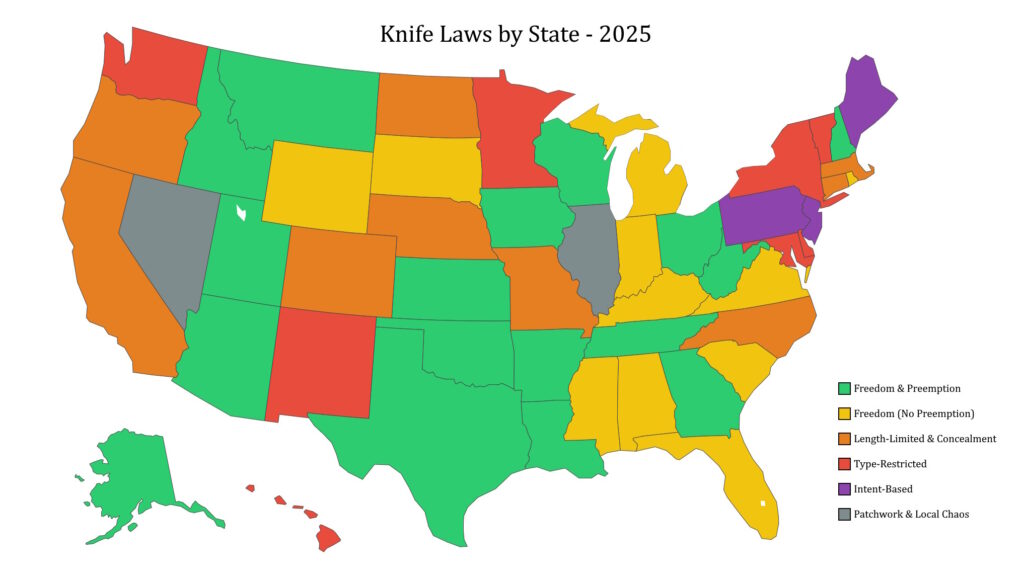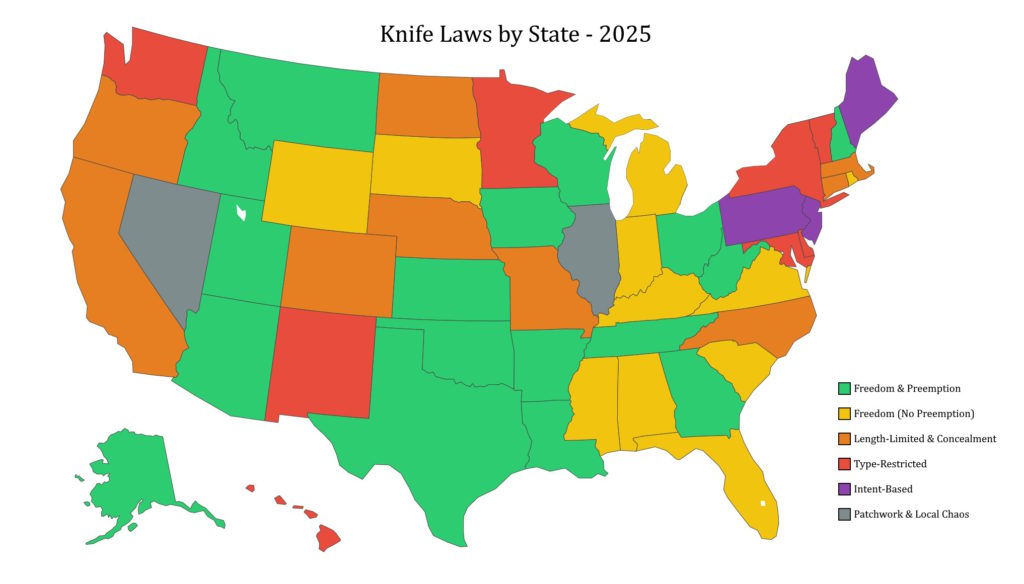
Knife laws in America are as sharp and unpredictable as the blades themselves. From the wild freedom of Texas to the gray zones of New Jersey, every state tells its own story of culture, crime policy, and common sense. What’s perfectly legal in one county could land you in trouble two towns over.
We’ve sorted 50 states into six clear “buckets” that share similar knife-law DNA — from total freedom to local chaos. Just remember: it’s an overview, not legal advice, and local ordinances can still override state rules. Always double-check before carrying, especially in big cities, schools, courthouses, and airports.
1. The Freedom & Preemption States
(17 States: Alaska, Arizona, Arkansas, Georgia, Idaho, Iowa, Kansas, Louisiana, Montana, New Hampshire, Ohio, Oklahoma, Tennessee, Texas, Utah, West Virginia, Wisconsin)
These are the states where knife ownership and carry are treated like any other tool. There are usually no statewide blade-length limits, and preemption laws prevent cities from layering on their own restrictions. You can carry one knife across the entire state line without falling into a municipal trap — whether you’re commuting in Dallas or hiking in Idaho.
Almost every blade type is fair game here, including automatics and OTF (open-the-front) knives. Texas even legalized large fixed blades for open carry, and Utah extends full reciprocity for knife rights. That open-carry freedom is exactly where Tekto’s A3 Delta automatic would feel right at home. It, and other blades like it (a sleek, rapid-deploy folder designed for durability and precision), are free to carry in states that actually trust their citizens with knives.
Just remember: even freedom states draw the line at places like courthouses, government buildings, and schools. Outside of those zones, though, this is where everyday-carry knives live their best lives.
2. The Freedom (No Preemption) States
(12 States: Alabama, Florida, Indiana, Kentucky, Michigan, Mississippi, South Carolina, South Dakota, Vermont, Virginia, Wyoming, Rhode Island)
This group feels just as free — until you cross city lines. The state laws are relaxed, but there’s no preemption, meaning counties or cities can set their own rules. So while a switchblade might be fine under state law, your city might still say otherwise.
Florida and Michigan recently lifted their switchblade bans, and Vermont remains one of the most permissive New England states. Still, locals like Detroit and Charleston maintain quirks worth checking before clipping on your knife. Think of these as “green-light” states with “yellow-light” cities: carry freely, but check the local fine print.

3. The Length-Limited & Concealment States
(9 States: California, Colorado, Connecticut, Missouri, Nebraska, North Carolina, North Dakota, Oregon, Massachusetts)
Here, what matters isn’t what you carry but how big it is and how you carry it. These states often set precise blade-length caps (2½ – 4 inches) or restrict concealed carry rather than banning ownership outright.
California’s famous 2-inch limit on switchblades and Colorado’s 3.5-inch concealed threshold are classic examples. Missouri allows longer blades for open carry but regulates concealed-weapon permits for larger knives. Massachusetts, after its 2024 court decision overturning the switchblade ban, still polices “dangerous-weapon” carry rules closely. Here, pocket clips and clear visibility help; deep concealment can turn legality into liability.
4. The Type-Restricted States
(8 States: Delaware, Hawaii, Maryland, Minnesota, New Mexico, New York, Washington, Vermont)
In these states, it’s not the size of your knife that matters — it’s the mechanism. The old “switchblade panic” lingers, and certain opening systems remain tightly controlled.
Minnesota and New Mexico ban automatics outright. Maryland allows ownership but not concealed carry. New York loosened its laws after court challenges, but NYC still enforces its own restrictions. Washington reserves autos for law enforcement, while even Vermont, known for its firearm freedoms, caps automatics at 3 inches. Manual folders, slip-joints, and fixed blades are the safest bets here.
5. The Intent-Based States
(3 States: Maine, New Jersey, Pennsylvania)
These are the “it depends” jurisdictions. Knife legality is defined not by length or design but by intent — a knife becomes illegal only if carried “as a weapon.”
That flexibility can cut both ways. New Jersey is especially subjective: a utility knife in your car might be fine one day and a “dangerous weapon” the next. Maine and Pennsylvania take similar stances. For carriers, context is everything. Keep your knives tied to obvious work, recreational, or culinary use, and avoid concealment that could look suspicious.
6. The Patchwork & Local Chaos States
(2 States: Illinois, Nevada)
These are the wildcards — where the state says one thing and major cities say another. In Illinois, state law looks moderate, but Chicago’s ordinance imposes strict limits and bans some knives outright. Nevada repealed its statewide switchblade ban, yet Clark County (Las Vegas) still enforces its own restrictions.
What’s legal in one suburb can be a misdemeanor downtown. Travelers and knife enthusiasts should take special care crossing county lines here — your pocketknife’s legality can change faster than a traffic signal.
Last modified: October 30, 2025







